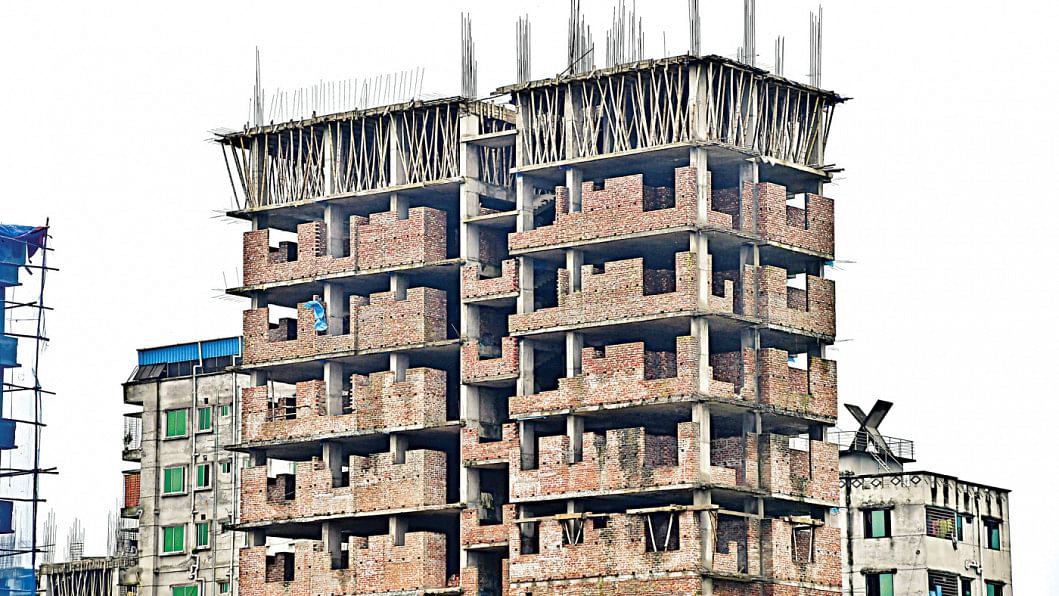Rajuk caves in to realtors’ pressure
Just over a year ago, the Rajdhani Unnayan Kartripakkha (Rajuk) adopted a new Detailed Area Plan (DAP), introducing height restrictions for buildings in a bid to enhance Dhaka's liveability.
However, the capital's development authority has backtracked on the decision and relaxed the restrictions, yielding to the pressure from real estate giants, who deemed the limitations to be a concern to their businesses.
The real estate companies expressed concerns that their businesses would be affected by the restrictions on Floor Area Ratio (FAR), a zoning regulation governing building size and density.
FAR is derived by dividing the total area of the building by the total area of the plot that the building is located on, and is expressed as a decimal number.
To this end, real estate developers, represented by Real Estate and Housing Association of Bangladesh (Rehab) and Bangladesh Land Developers Association, met with the state minister for the Ministry of Housing and Public Works on March 22 to discuss their demands.
Subsequently, Rajuk's chairman convened a meeting on May 18 to formulate 11 proposals for amending the DAP, which were ultimately approved by the prime minister on July 20.
DAP amendment will result in taller buildings along narrow roads, leading to reduced air circulation, diminished sunlight for city residents, and increased congestion in the areas, ultimately affecting the mental and physical well-being of the inhabitants.

WHAT'S IN THE AMENDMENT
According to the DAP amendment, building heights can be increased in three categories based on area types: planned, unplanned, and block-based residential areas.
In unplanned areas with 12-foot wide roads, such as Badda, Demra, Khilkhet, Uttarkhan, Dakshinkhan, Rayerbazar, Savar, and Keraniganj, landowners can now construct eight-storey buildings, whereas the previous limit was six-storey for 16-foot wide roads.
In planned areas with 25-foot wide roads, the DAP initially permitted construction of nine-storey buildings, but the amendment now allows landowners to construct ten-storey buildings.
Landowners, developers, and real estate giants have been advocating for an exemption from the FAR requirement since the gazette notification on the newly adopted DAP was published in August 2022.
They argued that if landowners had agreements with developers before the DAP's gazette date, they should be allowed to adhere to previous FAR regulations, which allowed for the construction of eight to ten-storey buildings, regardless of road width.
The amendment prioritised the interest of real estate and developers. The ministry or Rajuk did not hold any dialogue with other stakeholders.
Block-based development, where small land owners can merge their land with their fellow land owners to build housing blocks, will enjoy additional FAR as the amended DAP permitted them 20 percent in case of one to six bighas of land and 30 percent for 16 bighas and beyond.
WHAT URBAN PLANNERS ARE SAYING
Adil Mohammad Khan, executive director of the Institute for Planning and Development, told The Daily Star that amendment to the DAP comes as no surprise, as it had been facing resistance in its implementation from various vested quarters right after it was adopted.
"The amendment prioritised the interest of real estate and developers. The ministry or Rajuk did not hold any dialogue with other stakeholders," he alleged.
Adil pointed out that the DAP amendment will result in taller buildings along narrow roads, leading to reduced air circulation, diminished sunlight for city residents, and increased congestion in the areas, ultimately affecting the mental and physical well-being of inhabitants.
Architect Sujaul Islam Khan, a member of a working committee formed by Rajuk for reviewing the DAP, also expressed his dissatisfaction, saying they were not consulted or invited to the stakeholders' meeting, despite being part of the committee.
He emphasised that their recommendation was to restrict urbanisation in municipalities to protect agricultural land and waterbodies, placing blame on Rajuk for making the city more precarious through amendments favouring the interest groups.
Our recommendation was to restrict urbanisation in municipalities to protect agricultural land and waterbodies.
REHAB, RAJUK'S TAKE
However, Alamgir Alamin Kajol, president of Rehab, highlighted the critical importance of the DAP amendment for the real estate sector, which supports the livelihoods of millions of people and has a significant impact on the economy.
"Our economy can't move ignoring the real estate sector, which involves around 270 sub-sectors of the country. We think the government finally realised the fact, considering all aspects and brought changes where it deemed fit based on reality," he added.
Md Ashraful Islam, project director of DAP and also town planner of Rajuk, said this amendment will encourage landowners to hand over a portion of their land for green space.
The official mentioned that they initially tried to motivate landowners by offering increased FAR, up to a certain extent, following global practices. However, when it came to block development, landowners showed reduced enthusiasm for accepting the offer and preserving green spaces.
"Since landowners perceived that the benefits of preserving green space were limited compared to using their land for development, we decided to raise the FAR to encourage them to allocate a portion of their land for green spaces," he said.
Coming up with an example, he said if there is a block development on one bigha of land (20 katha), before the amendment, they had to leave 12 katha for green space and could construct a building on the remaining land, which demotivated them to do so.
He emphasised that the increase in FAR was introduced as an incentive to expand the green space, refuting allegations of succumbing to pressure from developers and real estate groups.

 For all latest news, follow The Daily Star's Google News channel.
For all latest news, follow The Daily Star's Google News channel. 


Comments